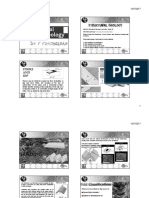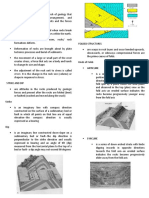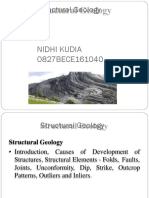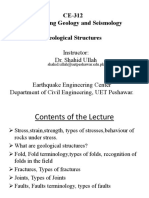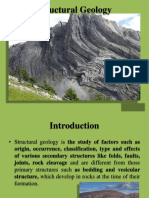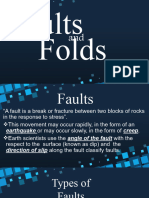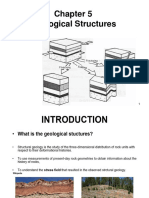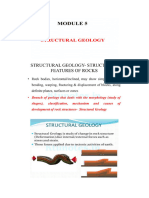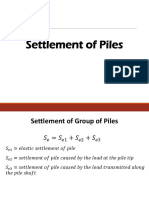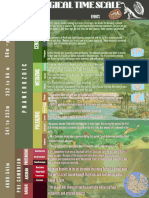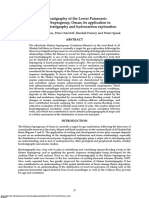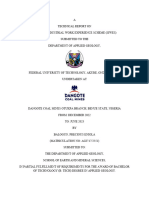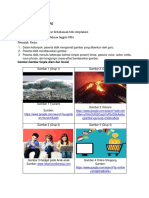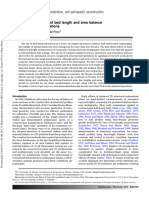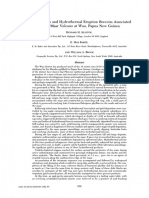Structural Geology
The folded and metamorphosed rocks shown in figure.
It was once flat-lying sedimentary strata. Compressional forces
of unimaginable magnitude, combined with temperatures
hundreds of degrees above surface conditions, prevailed for
thousands or millions of years to produce the deformation
displayed by these rocks.
Under such extreme conditions, solid rock responds by
folding, fracturing, and often flowing.
1
�Structural Geology
Contents
Structural Geology: Attitude of beds, study of structures
folds, faults, fractures and joints classification, recognition
in the field, relevance to civil engineering.
2
�Notice the complexity
3
�Structural Geology
Strike
The compass direction of the line produced by the
intersection of an inclined rock layer or fault with a
horizontal plane
Generally expressed an angle relative to north
Dip
The angle of inclination of the surface of a rock unit or
fault measured from a horizontal plane
Includes both an inclination and a direction toward
which the rock is inclined
4
�Structural Geology
5
�Structural Geology
True Dip –
Measured @ right
angles to the strike.
Apparent Dip –
Angle measured in
any other direction
than the true dip
direction
6
�Folds
Most common geological structures found in rocks
When a set of horizontal layers are subjected to compressive
forces, they bend either upward or downward.
Bend noticed in rocks – folds
Folds – May occur as single local bends
Folds – Repeatedly or intricately folded based on tectonics
Folds – May occur due to crustal deformations bent into a series
of undulations.
Characteristics – Mostly resulting from compressive stresses
which shorten & thicken the crust
7
�8
�Terminology of Folds
Characteristics of folds
Parts of a fold
Limbs – refers to the two sides of a fold
Axis – a line drawn down the points of maximum
curvature of each layer
Axial plane – an imaginary surface that divides a fold
symmetrically
Horizontal (A) and plunging (B) anticlines
9
�Anticline and syncline
Anticline
Beds bent upward resulting in Anticline. Fold is convex upwards.
Older beds occur towards concave side.
Simple case – limbs of anticline slope in opposite directions w.r.t
axial plane
Syncline
Beds are bent downwards, resulting fold is Syncline. Convex
downwards. Younger beds at concave side
Simple case – limbs dips towards each other w.r.t axial plane
10
�Common types of folds
Common types of folds
Anticline – upfolded or arched rock layers
Syncline – downfolds or troughs of rock layers
Depending on their orientation, anticlines and
synclines can be described as
Symmetrical, asymmetrical, recumbent (an
overturned fold), or plunging
11
�Syncline (left) anticline (right)
12
�13
�14
�Plunge – Inclination of fold axis to the horizontal plane
15
�16
�17
�18
� Un-Equal thickness,
Equal thickness Un-Equal thickness
Undulated Shape
Notice the shape, thickness of the bed and pattern
19
�20
�21
�22
�23
�24
�25
�26
�27
�Causes of Folding
Tectonic Causes Non-Tectonic causes
Lateral compressions Land sliding
Creeping
Igneous Intrusions Differential Compaction
Isostatic setting
Salt Intrusions Subsidence into solution cavities
Glaciation
Tectonic Causes of Folding
Lateral compression
Lateral compression- soft
viscous material
Salt intrusion
Igneous intrusion
28
�Non-Tectonic Causes of Folding
Differential compaction
Landsliding Creeping
Isostatic settling Subsidence in solution cavities
29
�30
�31
�Common types of folds
Monoclines – Large step like folds in otherwise
horizontal sedimentary strata
Often result of
buried faults
Other types of folds
Domes
Upwarped displacement of rocks
Circular or slightly elongated structure
Oldest rocks in center, younger rocks on the flanks
Basins
Circular or slightly elongated structure
Down warped displacement of rocks
Youngest rocks are found near the center, oldest rocks
on the flanks
32
�Domes and basins both exhibit circular patterns
Engineering Considerations
Folded rocks are under considerable strain and hence excavation
through them may be accompanied by slip and rock bursts
Synclinal folded rocks may yield hard and tough quality stones,
where as anticlinal folded rocks will yield weaker stones.
Folded rocks are generally shattered and weak, particularly in the
axial region and are unsafe for roofs and floors of tunnels or
foundation for dams.
Fractured folded rocks are highly permeable
Folded rocks are great prospect for ground water
The anticlinal folds are round prospects for stored petroleum.
33
�Structural Geology
Structural Geology
34
�Faults
Faults are fractures in rocks along which appreciable
displacement has taken place.
Sudden movements along faults are the cause of most
earthquakes.
Classified by relative movements which can be
horizontal, vertical or oblique.
Notice the layers and Fault
action
35
�36
�Magnitudes can be < 1 cm to several Km. Depends on
intensity and nature of ----- ?
37
�38
�Throw – Vertical Distance
along the dip & Heave –
Horizontal distance along
Strike
39
�40
�41
�42
�Causes of Faulting
Tectonic Causes
Shear and sliding failures
Magmatic intrusions E.g. Bysmaliths
Local settlement under the influence of gravity
43
�There are two types of movement
44
�45
�46
�47
�48
�49
�50
�51
�52
�53
�54
�55
�56
�57
�58
�Engineering Considerations of Faults
There may be chances of movement - causing instability in the
structure.
Avoid major structure on fault or vicinity of fault.
Scattered project like installation of electrical lines may be
undertaken in the faulted region.
Much precaution needed for the seismic effects caused by the
movement along the fault.
59
�60


